
A fireteam or fire team is a small military sub-subunit of infantry designed to optimize "bounding overwatch" and "fire and movement" tactical doctrine in combat. Depending on mission requirements, a typical fireteam consists of four or fewer members: an automatic rifleman, a grenadier, a rifleman, and a designated team leader. The role of each fireteam leader is to ensure that the fireteam operates as a cohesive unit. Two or three fireteams are organized into a section or squad in co-ordinated operations, which is led by a squad leader. Historically, nations with effective fireteam organization have had a significantly better performance from their infantry units in combat than those limited to operations by traditionally larger units.

Trench warfare is the type of land warfare using occupied lines largely comprising military trenches, in which troops are well-protected from the enemy's small arms fire and are substantially sheltered from artillery. Trench warfare became archetypically associated with World War I (1914–1918), when the Race to the Sea rapidly expanded trench use on the Western Front starting in September 1914.
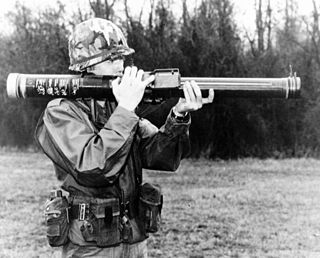
Anti-tank warfare originated from the need to develop technology and tactics to destroy tanks during World War I. Since the Triple Entente deployed the first tanks in 1916, the German Empire developed the first anti-tank weapons. The first developed anti-tank weapon was a scaled-up bolt-action rifle, the Mauser 1918 T-Gewehr, that fired a 13.2mm cartridge with a solid bullet that could penetrate the thin armor of tanks of the time and destroy the engine or ricochet inside, killing occupants. Because tanks represent an enemy's strong force projection on land, military strategists have incorporated anti-tank warfare into the doctrine of nearly every combat service since. The most predominant anti-tank weapons at the start of World War II in 1939 included the tank-mounted gun, anti-tank guns and anti-tank grenades used by the infantry, and ground-attack aircraft.

Close-quarters combat (CQC) or close-quarters battle (CQB) is a close combat situation between multiple combatants involving ranged or melee combat. It can occur between military units, law enforcement and criminal elements, and in other similar situations.

In military science, suppressive fire is "fire that degrades the performance of an enemy force below the level needed to fulfill its mission". When used to protect exposed friendly troops advancing on the battlefield, it is commonly called covering fire. Suppression is usually only effective for the duration of the fire. It is one of three types of fire support, which is defined by NATO as "the application of fire, coordinated with the maneuver of forces, to destroy, neutralise or suppress the enemy".
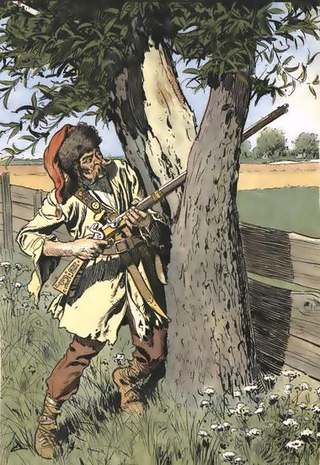
Skirmishers are light infantry or light cavalry soldiers deployed as a vanguard, flank guard or rearguard to screen a tactical position or a larger body of friendly troops from enemy advances. They are usually deployed in a skirmish line, an irregular open formation that is much more spread out in depth and in breadth than a traditional line formation. Their purpose is to harass the enemy by engaging them in only light or sporadic combat to delay their movement, disrupt their attack, or weaken their morale. Such tactics are collectively called skirmishing.

In warfare, infiltration tactics involve small independent light infantry forces advancing into enemy rear areas, bypassing enemy frontline strongpoints, possibly isolating them for attack by follow-up troops with heavier weapons. Soldiers take the initiative to identify enemy weak points and choose their own routes, targets, moments and methods of attack; this requires a high degree of skill and training, and can be supplemented by special equipment and weaponry to give them more local combat options.

Fire support is a military term used to describe weapons fire used to support friendly forces by engaging, suppressing, or destroying enemy forces, facilities, or materiel in combat. It is often provided through indirect fire, though the term may also be used for some forms of supporting direct fire.
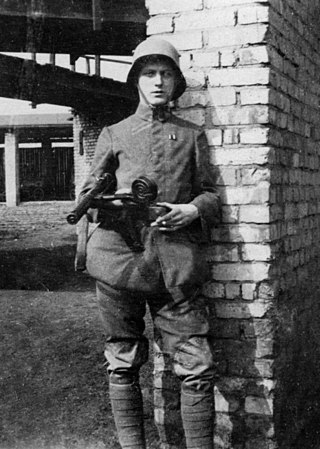
Stormtroopers were specialist infantry soldiers of the German Army. In the last years of World War I, Stoßtruppen were trained to use infiltration tactics – part of the Germans' improved method of attack on enemy trenches. The German Empire entered the war certain that the conflict would be won in the course of great military campaigns, thus relegating results obtained during individual clashes to the background; consequently the best officers, concentrated in the German General Staff, placed their attention on maneuver warfare and the rational exploitation of railways, rather than concentrating on the conduct of battles: this attitude gave a direct contribution to operational victories of Germany in Russia, Romania, Serbia and Italy, but it resulted in failure in the West. Thus the German officers on the Western Front found themselves in need of resolving the static situation caused by trench warfare on the battlefield.
Maneuver warfare, or manoeuvre warfare, is a military strategy which seeks to shatter the enemy's overall cohesion and will to fight.

Infantry tactics are the combination of military concepts and methods used by infantry to achieve tactical objectives during combat. The role of the infantry on the battlefield is, typically, to close with and engage the enemy, and hold territorial objectives; infantry tactics are the means by which this is achieved. Infantry commonly makes up the largest proportion of an army's fighting strength, and consequently often suffers the heaviest casualties. Throughout history, infantrymen have sought to minimise their losses in both attack and defence through effective tactics.

Firepower is the military capability to direct force at an enemy. Firepower involves the whole range of potential weapons. The concept is generally taught as one of the three key principles of modern warfare wherein the enemy forces are destroyed or have their will to fight negated by sufficient and preferably overwhelming use of force as a result of combat operations.
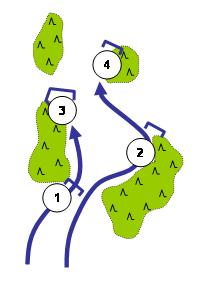
Bounding overwatch is a military tactic of alternating movement of coordinated units to allow, if necessary, suppressive fire in support of offensive forward "fire and movement" or defensive "center peel" disengagement.
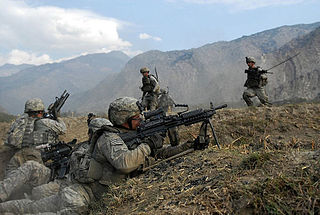
Small unit tactics is the application of US Army military doctrine for the combat deployment of platoons and smaller units in a particular strategic and logistic environment. The composition of a United States Army squad falls into three broad categories: classical, balanced and combined.

Shock tactics, shock tactic, or shock attack is the name of an offensive maneuver which attempts to place the enemy under psychological pressure by a rapid and fully-committed advance with the aim of causing their combatants to retreat. The acceptance of a higher degree of risk to attain a decisive result is intrinsic to shock actions.
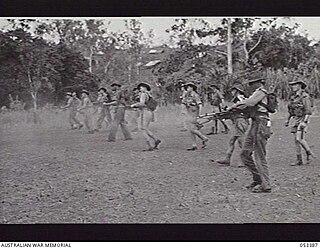
Marching fire, also known as walking fire, is a military tactic—a form of suppressive fire used during an infantry assault or combined arms assault. Advancing units fire their weapons without stopping to aim, in an attempt to pin down enemy defenders. Marching fire usually ends with an infantry charge to engage the enemy in close combat. The tactic requires ample ammunition and rapid-fire weapons. It differs from fire and movement in that the attacking force advances in unison rather than leapfrogging forward in alternating groups.
A platoon is a military unit of the United States Army. It is generally the smallest unit to be commanded by a commissioned officer, known as the platoon leader, currently a first or second lieutenant. The senior-most non-commissioned officer assists the platoon leader as platoon sergeant, currently a sergeant first class.
















